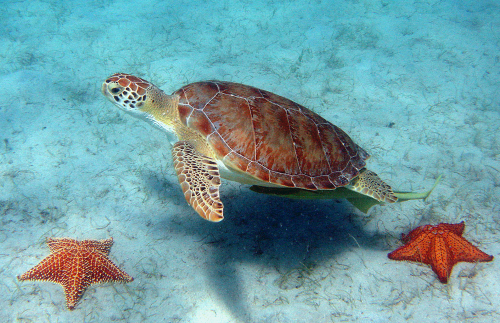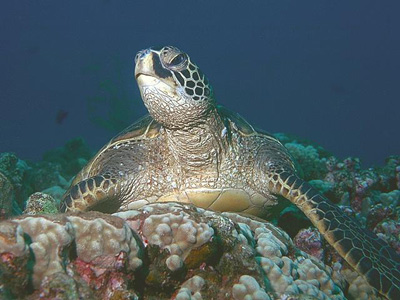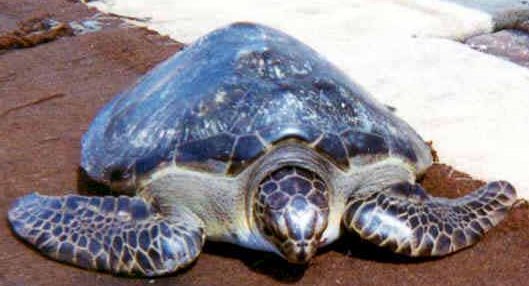Green Sea Turtle

Common Name: Green Sea Turtle
Scientific Name: Chelonia mydas
Description
Green turtles are the largest of the hard-shelled sea turtles with adults reaching a meter (3.3 feet) in carapace length and 150 kg (330 pounds) in weight. They have a smooth carapace with four pairs of lateral scutes and a single pair of elongated prefrontal scales between the eyes. The plastron remains a yellowish white, but the carapace changes color from solid black to a variety of shades of grey, green, brown and black in starburst or irregular patterns. Green turtle hatchlings are about 50 mm (2.0 inches) long and weight about 25 g (0.88 ounces).
Adult green turtles are unique among sea turtles in that they are herbivorous, feeding primarily on seagrasses and algae. This diet is thought to give them greenish colored fat, from which they take their name. A green turtle's carapace (top shell) is smooth and can be shades of black, gray, green, brown, and yellow. Their plastron (bottom shell) is yellowish white.
Scientists estimate green turtles reach sexual maturity anywhere between 20 and 50 years, at which time females begin returning to their natal beaches (i.e., the same beaches where they were born) every 2-4 years to lay eggs.
The nesting season varies depending on location. In the southeastern U.S., females generally nest between June and September, while peak nesting occurs in June and July. During the nesting season, females nest at approximately two week intervals, laying an average of five clutches. In Florida, green turtle nests contain an average of 135 eggs, which will incubate for approximately 2 months before hatching.
Habitat

Green turtles primarily use three types of habitat: oceanic beaches (for nesting), convergence zones in the open ocean, and benthic feeding grounds in coastal areas. Adult females migrate from foraging areas to mainland or island nesting beaches and may travel hundreds or thousands of kilometers each way. After emerging from the nest, hatchlings swim to offshore areas, where they are believed to live for several years, feeding close to the surface on a variety of pelagic plants and animals. Once the juveniles reach a certain age/size range, they leave the pelagic habitat and travel to nearshore foraging grounds. Once they move to these nearshore benthic habitats, adult green turtles are almost exclusively herbivores, feeding on sea grasses and algae.
Green turtles are generally found in fairly shallow waters (except when migrating) inside reefs, bays, and inlets. The turtles are attracted to lagoons and shoals with an abundance of marine grass and algae. Open beaches with a sloping platform and minimal disturbance are required for nesting. Green turtles apparently have a strong nesting site fidelity and often make long distance migrations between feeding grounds and nesting beaches. Hatchlings have been observed to seek refuge and food in Sargassum rafts.
Distribution
The green turtle is globally distributed and generally found in tropical and subtropical waters along continental coasts and islands between 30 North and 30 South. Nesting occurs in over 80 countries throughout the year (though not throughout the year at each specific location). Green turtles are thought to inhabit coastal areas of more than 140 countries.
Threats
The principal cause of the historical, worldwide decline of the green turtle is long-term harvest of eggs and adults on nesting beaches and juveniles and adults on feeding grounds. These harvests continue in some areas of the world and compromise efforts to recover this species. Incidental capture in fishing gear, primarily in gillnets, but also in trawls, traps and pots, longlines, and dredges is a serious ongoing source of mortality that also adversely affects the species' recovery. Green turtles are also threatened, in some areas of the world, by a disease known as fibropapillomatosis (FP).
Reproduction and Development
The nesting season varies with the locality. In the Southeastern U.S., it is roughly June through September. Nesting occurs nocturnally at 2, 3, or 4-year intervals. Only occasionally do females produce clutches in successive years. A female may lay as a many as nine clutches within a nesting season (overall average is about 3.3 nests per season) at about 13-day intervals. Clutch size varies from 75 to 200 eggs, with an average clutch size of 136 eggs reported for Florida. Incubation ranges from about 45 to 75 days, depending on incubation temperatures. Hatchlings generally emerge at night. Age at sexual maturity is believed to be 20 to 50 years.
Range and Population LevelThe green turtle has a worldwide distribution in tropical and subtropical waters. Major green turtle nesting colonies in the Atlantic occur on Ascension Island, Aves Island, Costa Rica, and Surinam. Within the U.S., green turtles nest in small numbers in the U.S. Virgin Islands, Puerto Rico, Georgia, South Carolina, and North Carolina, and in larger numbers in Florida. The Florida green turtle nesting aggregation is recognized as a regionally significant colony. About 200 to 1,100 females are estimated to nest on beaches in the continental U.S. In the U.S. Pacific, over 90 percent of nesting throughout the Hawaiian archipelago occurs at the French Frigate Shoals, where about 200 to 700 females nest each year. Elsewhere in the U.S. Pacific, nesting takes place at scattered locations in the Commonwealth of the Northern Marianas, Guam, and American Samoa. In the western Pacific, the largest green turtle nesting aggregation in the world occurs on Raine Island, Australia, where thousands of females nest nightly in an average nesting season. In the Indian Ocean, major nesting beaches occur in Oman where 6,000 to 20,000 females are reported to nest annually.
Critical Habitat50 CFR 226.208 Culebra Island, Puerto Rico - Waters surrounding the island of Culebra from the mean high water line seaward to 3 nautical miles (5.6 km). These waters include Culebra's outlying Keys including Cayo Norte, Cayo Ballena, Cayos Geniqu, Isla Culebrita, Arrecife Culebrita, Cayo de Luis PeZa, Las Hermanas, El Mono, Cayo Lobo, Cayo Lobito, Cayo Botijuela, Alcarraza, Los Gemelos, and Piedra Steven.
Reasons for Current StatusA major factor contributing to the green turtle's decline worldwide is commercial harvest for eggs and meat. Fibropapillomatosis, a disease of sea turtles characterized by the development of multiple tumors on the skin and internal organs, is also a mortality factor and has seriously impacted green turtle populations in Florida, Hawaii, and other parts of the world. The tumors interfere with swimming, eating, breathing, vision, and reproduction, and turtles with heavy tumor burdens become severely debilitated and die. Other threats include loss or degradation of nesting habitat from coastal development and beach armoring; disorientation of hatchlings by beachfront lighting; excessive nest predation by native and non-native predators; degradation of foraging habitat; marine pollution and debris; watercraft strikes; and incidental take from channel dredging and commercial fishing operations.
Management and Protection
In the Southeast United States, major nest protection efforts and beach habitat protection are underway for most of the significant nesting areas, and significant progress has been made in reducing mortality from commercial fisheries in U.S. waters with the enforcement of turtle excluder device regulations. Many coastal counties and communities in Florida have developed lighting ordinances to reduce hatchling disorientations. Important U.S. nesting beaches have been and continue to be acquired for long-term protection. The Fish and Wildlife Service and National Marine Fisheries Service have been funding research on the fibropapilloma disease for several years to expand our knowledge of the disease with the goal of developing an approach for remedying the problem. Due to the long range migratory movements of sea turtles between nesting beaches and foraging areas, long-term international cooperation is absolutely essential for recovery and stability of nesting populations.
 Deep Sea Crabs
Deep Sea Crabs